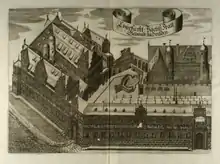Paul Buchner
Paul Buchner (June, 1531 - 13 November, 1607) was a German architect, geometer, carpenter, and screw maker from Nuremberg, Germany.

Life

Buchner grew up in Nuremberg and was an apprentice carpenter and screw maker, training under his cousin, Leonhard Danner. In 1556 he worked for Queen Elizabeth I in London, where his job was to produce screws which would be used to strengthen fortifications. In 1557 Duke Emmanuel Philibert of Savoy invited him to Brussels.
On a recommendation from Leonhard Danner, who supplied military equipment for the Saxon court, August of Saxony invited Buchner in 1558 to Dresden. He made screw tools before being appointed as an electoral master craftsman in 1559, then became commander of the Dresden arsenal in 1563. He worked with Voigt von Wierandt, an experienced architect and master builder. Starting in 1567 he supervised the expansion of Dresden's fortifications. Due to his extensive knowledge of fortress construction and weapons technology, Buchner was appointed as a master of the house and land of Dresden in 1575. He was then responsible for all fortifications and armories throughout Saxony.
From 1586 to 1590, Buchner built the Dresden Stallhof (the Stable Building) at the Jüdenhof under Elector Christian I.[1] Buchner was later married to Maria Kröß, the daughter of a chamber servant in the Electorate of Saxony and the mayor of Dresden, Bastian Kröß.[2] Together, Buchner and Kröß were the parents of the scholar August Buchner.
Buchner died in 1607 in Dresden, and was buried at the Frauenkirchhof in Dresden.
The medalist Tobias Wolff made a portrait medal of Paul Buchner depicting him at the age of 49.[3]
Works
- Collaboration on the Dresden Armoury (Zeughaus) - 1559-1563
- Conversion of Wilsdruffer Gate at Dresden - 1568
- Powder Mill at Dresden - 1574-1575
- Conversion of Castle Gommern into a hunting lodge - 1578
- Dresden Stallhof (the Stable Building) at the Jüdenhof (1586-1589) of Dresden Castle, today the Dresden Transport Museum
- Electoral Stable Building, also known as the "Old Castle" at Zabeltitz - 1588-1598
- Extension of the Königstein Fortress in 1589 (Gate House, Old Armoury, Guard House, Christiansburg)
- Pirna Gate at Dresden - 1590-1591
- Old Gewandhaus at Dresden - 1591
 Stallhof Dresden, engraving 1680, by Anton Weck
Stallhof Dresden, engraving 1680, by Anton Weck Long corridor in the Stallhof Dresden, engraving 1680, by Anton Weck
Long corridor in the Stallhof Dresden, engraving 1680, by Anton Weck Entrance to the Stallhof Dresden
Entrance to the Stallhof Dresden Stallhof Dresden
Stallhof Dresden The Pirnaische Tor Dresden 1679
The Pirnaische Tor Dresden 1679 Zabeltitz Castle
Zabeltitz Castle Königstein Fortress, Altes Zeughaus
Königstein Fortress, Altes Zeughaus Königstein Fortress, Altes Zeughaus
Königstein Fortress, Altes Zeughaus
Sources
- Esther Hoppe-Münzberg: The Elector's Stable and Armory Chamber Building with Long Corridor and Stable Courtyard - a new construction task in the complex of the Dresden Residential Palace in: Saxony State Office for the Preservation of Monuments (Ed.): The Residence Palace of Dresden. Volume 2: The castle complex of the Renaissance and its early baroque alterations and decorations. Petersberg 2019, pp. 397-419.
- : Hans von Dehn-Rothfelser. Ein Beitrag zur Kunstgeschichte Sachsens (online at Google Books). Blochmann, Dresden 1877, on Buchner pp. 36-43.
References
- Esther Hoppe-Münzberg: Das Kurfürstliche Stall- und Harnischkammergebäude mit Langem Gang und Stallhof – eine neue Bauaufgabe im Komplex des Dresdner Residenzschlosses in: Landesamt für Denkmalpflege Sachsen (ed.): Das Residenzschloss zu Dresden. Band 2: Die Schlossanlage der Renaissance und ihre frühbarocken Um- und Ausgestaltungen. Petersberg 2019, pp. 397-419. According to current research and sources, there is no basis for the discussed participation of the master builder Hans Irmisch in the design or construction process. Cf. Esther Hoppe-Münzberg, 2019 (p. 404).
- Heinrich Kramm: Die Bürgermeister von Dresden 1549-1806, in: Studien über die Oberschichten der mitteldeutschen Städte im 16. Jahrhundert, Mitteldeutsche Forschungen, Band 87, Verlag Böhlau Köln/Wien, 1981, p. 716.
- The undated medal is in the collection of the Kunsthistorisches Museum Vienna, Münzkabinett. An illustration can be found in the German Digital Library(DDB): https://ausstellungen.deutsche-digitale-bibliothek.de/festungxperience/items/show/13 Illustration of the medal
External links
| Wikimedia Commons has media related to Paul Buchner (architect). |